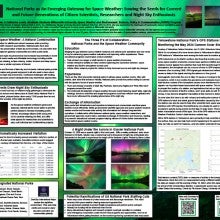National Parks as An Emerging Gateway for Space Weather: Sowing the Seeds for Current and Future Generations of Citizen Scientists, Researchers and Night Sky Enthusiasts
Steve
Luther
Millersville University
Poster
National parks play a key role in preserving Earth’s most pristine natural wonders and landmarks, offering protection for wildlife and cultural resources while providing affordable public access and offering unparalleled research opportunities. The parks have also increasingly become a haven for the preservation of dark sky environments, not only within their physical boundaries but also for adjacent gateway communities
Public interest in space weather and night sky phenomena has increased exponentially in recent years thanks to the proliferation of social media and affordable technology including mobile phones and digital cameras. Aurora chasing, eclipse viewing, meteor showers and deep space documentation have resultantly seen a similar explosion of interest.
However, with ever-increasing light pollution and the loss of dark sky environments, national parks provide havens for study, research, observation and general enjoyment to all who seek to learn about and understand space weather and night sky phenomena.
In this poster, we aim to show the important role national parks globally do and can play, along with resultant challenges they face and recommendations for future development. Of note, my co-author is a former US national park wilderness ranger. Specific topics covered:
- Best national parks for dark sky observation
- How Yellowstone National Park uses GPS monitoring to predict solar storms
- The many parks which offer dedicated dark/night sky events and activities
- The proliferation of visitation at parks during large-scale space weather events and resulting challenges
- How collaboration will be key for national parks and the space weather community is crucial going forward
Public interest in space weather and night sky phenomena has increased exponentially in recent years thanks to the proliferation of social media and affordable technology including mobile phones and digital cameras. Aurora chasing, eclipse viewing, meteor showers and deep space documentation have resultantly seen a similar explosion of interest.
However, with ever-increasing light pollution and the loss of dark sky environments, national parks provide havens for study, research, observation and general enjoyment to all who seek to learn about and understand space weather and night sky phenomena.
In this poster, we aim to show the important role national parks globally do and can play, along with resultant challenges they face and recommendations for future development. Of note, my co-author is a former US national park wilderness ranger. Specific topics covered:
- Best national parks for dark sky observation
- How Yellowstone National Park uses GPS monitoring to predict solar storms
- The many parks which offer dedicated dark/night sky events and activities
- The proliferation of visitation at parks during large-scale space weather events and resulting challenges
- How collaboration will be key for national parks and the space weather community is crucial going forward

Poster PDF
Poster category
Space Weather Policy and General Space Weather Contributions
Meeting homepage